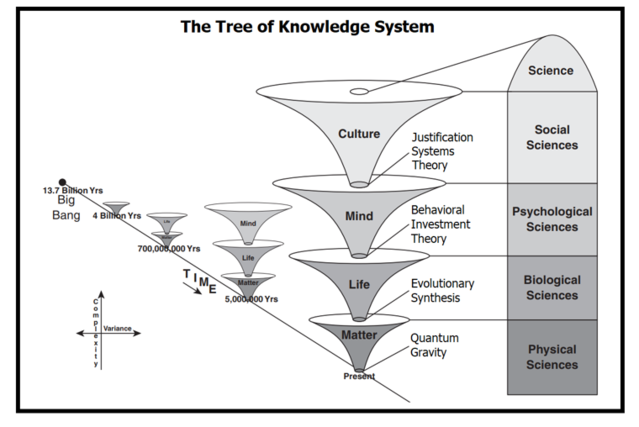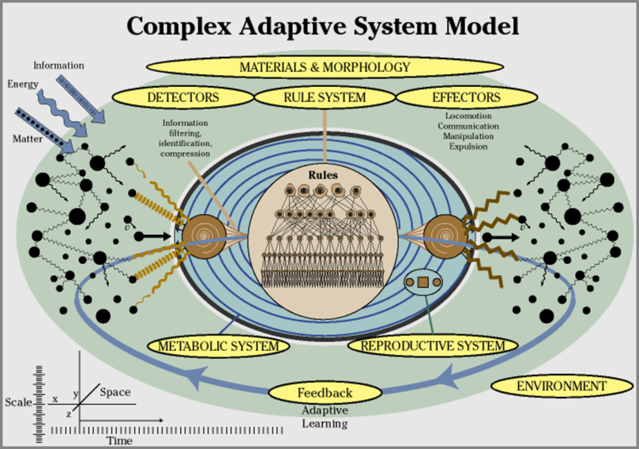The Metaphysical Mystery of Life, Mind, and Culture
Solving the metaphysical mystery of life, mind, and culture.
by Gregg Henriques Ph.D.Galileo is generally credited with being the father of modern science. As this lecture aptly describes, he completely eschewed metaphysics and got along with the business of empirically and mathematically mapping matter in motion.
Although this was a boon for physics and for our understanding of the material dimension of complexity, it created a serious problem. As the lecture points out, metaphysics is required for understanding. What Galileo and many of the modern scientists who came after him failed to realize is that there is a big difference between pure metaphysics and descriptive metaphysics. At its descriptive base, metaphysics simply refers to the concepts and categories we employ to understand the world. Defining what an object is, what a cause is, what behavior is are all metaphysical questions. They are descriptive metaphysical questions. Crucially, these concerns are different from pure metaphysical questions, which are claims about the nature of existence that have no empirical referent. With its commitment to empirical data, naturalistic science should eschew pure metaphysical questions, but embrace the need for descriptive metaphysical systems that provide the appropriate concepts and categories for describing the patterns of behavior that we can empirically observe occurring in the world (see here and here).
Framed this way, we can see that modern science is a descriptive metaphysical system of definitions and justifications that works via the application of the empirical method to describing patterns of behavior. Unfortunately, a serious problem in modern science is that the so-called “special sciences” (i.e., the biological, psychological, and social sciences) have been hampered by being required to describe their phenomena of interest via the language game of physics. Consider, for example, that “behavior” is one of the most important words in psychology. Why? If you go back to Watson (see here), the primary reason was because he and the early behaviorists were trying to parrot the physicists and conform to their language game of physical cause and effect.
The 21st Century needs a new descriptive metaphysical system for science writ large. In his book The Orders of Nature, the philosopher Laurence Cahoone explained why. He criticized both philosophy and reductive physicists for their errors and showed how we should see the living, the mental, and the cultural orders of nature as being distinct from the material. This is the argument that the Tree of Knowledge System makes as well. Indeed, that is a primary point of the graphic.

So, let us ask, what, fundamentally, is the difference between the behavior of atoms contrasted with the behavior patterns of cells, animals, and people? Entities like electrons, helium atoms, sugar molecules, asteroids, rivers, and stars all behave at the material dimension of behavioral complexity. They are complicated, but they are not complex adaptive systems (see here).
In contrast, cells, animals, and people are complex adaptive systems. As this diagram shows, a complex adaptive system consists of a set of key components that regulate its behavioral patterns. These include detectors that bring in information, a rule system that stores information, processes it and translates that into effectors that generate responses. In their Tree of Knowledge, Maturana and Varela aptly characterized this dynamic, self-organizing process as "autopoetic".

Cells and organisms like trees have information storage that takes place at the genetic/epigenetic dimension. That is, information is stored in the DNA and RNA and coordinated via protein generation, and activated based on developmental rules and the energy, matter, and information brought in through the cell membrane. All of this evolves on an epigenetic/ontogenetic developmental pathway.
Animals with brains and complex bodies are, of course, organisms, so all the above is happening. However, they also have a higher order, coordinating rule system embedded in the brain and nervous system that regulates the behavior of the animal as a whole. For an animal like a rat, its “detectors” are its external and inner sensory systems that model where the animal is, relative to where its drive is to be, and that generates emotional reactions that organize action toward the desired outcomes and away from costly ones.
People are, of course, animals with complex brains and bodies. But they also have a symbolic rule system which is organized into a hierarchical structure of justification that connects them to their culture and functions to regulate their actions in accordance with their basic desires, their self-conscious beliefs, and relational world. This is the system that allows me to make the argument that I am making that Culture does not reduce to physical causation (see here).
Let’s get back to physics and metaphysics. The concept of metaphysics has its roots in Aristotle, who argued for the need for a first philosophy to describe the world. Central to his metaphysics was his description of four causes, namely substance, efficient (which we can call kinetic), formal, and final (see here for definitions). In developing his matter in motion framework, even though he hated metaphysics, Galileo necessarily pulled in substance and kinetic causation--they are part and parcel to describing matter in motion. However, he eschewed formal and final causation, which was smart because he was concerned with the Matter plane of existence.
Unfortunately, as Cahoone notes, this physicalist language game greatly hampers the biological, psychological, and social sciences. Why? Because, as the complex adaptive system diagram highlights, cells, animals, and people process information* and move in goal-oriented ways. In other words, to describe the behavior of cells, animals, and people, we needs the concepts of information processing and communication (formal causation) and purpose (final causation). Complexity theory shows why this is necessary as part of our descriptive language system.
The problem is that the physicists confused their laws, their language, and their metaphysical presuppositions regarding the basic facts of causation. This gave rise to a reductive physicalist view of the universe that was tragic, something Ken Wilber rightly called the “materialistic flatland view” which is a deeply misguided and disorienting metaphysics.
The Tree of Knowledge theory of scientific knowledge resolves our metaphysical problems and allows us to develop a consilient model of science across the physical, biological, psychological and sociocultural dimensions of behavioral complexity. Complex adaptive systems, couple with the ToK shows why we need the concept of strong emergence and why the special sciences cannot be reduced to physical science language games and presuppositions about causation.
______________
*I mean information processing both in terms of the theoretical sense of reducing uncertainty and the semantic sense of meaning making. I would also want to emphasize, ala Marshall McLuhan, the medium and communication processes. Information processing is a nebulous, but important topic that requires a separate discussion. I argue the ToK resolves the common confusions.